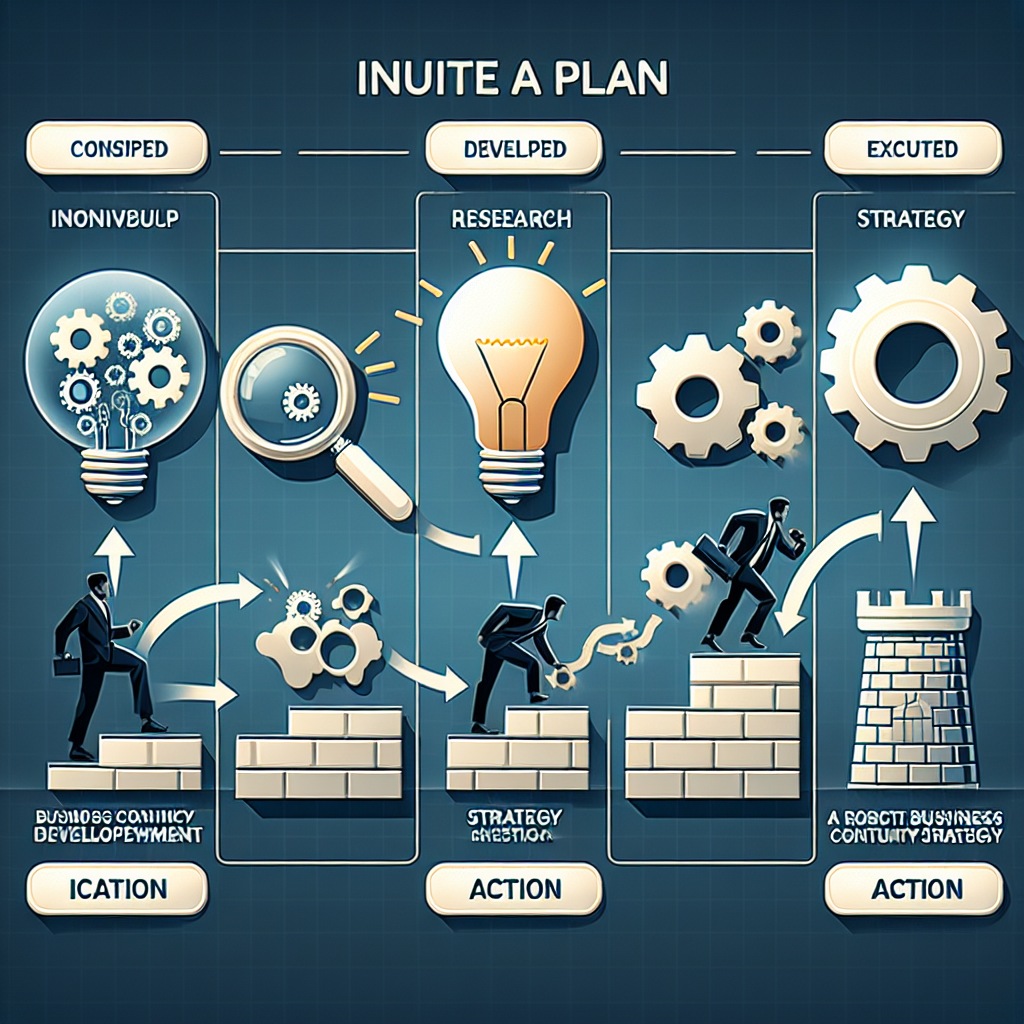Your cart is currently empty!
Tag: Robust

How to Ensure Business Continuity with a Robust Disaster Recovery Plan
In today’s rapidly changing business landscape, it is crucial for companies to have a robust disaster recovery plan in place to ensure business continuity. Natural disasters, cyber attacks, and other unforeseen events can disrupt operations and have a significant impact on a company’s bottom line. By having a comprehensive disaster recovery plan in place, businesses can minimize downtime, protect their data, and quickly resume operations in the event of a disaster.Here are some key steps that businesses can take to ensure business continuity with a robust disaster recovery plan:
1. Identify potential risks: The first step in creating a disaster recovery plan is to identify potential risks that could disrupt business operations. This includes natural disasters such as earthquakes, hurricanes, and floods, as well as man-made threats such as cyber attacks, power outages, and equipment failures.
2. Assess the impact: Once potential risks have been identified, businesses should assess the potential impact of these risks on their operations. This includes evaluating the potential loss of revenue, data, and customer trust that could result from a disaster.
3. Develop a plan: Based on the risks and their potential impact, businesses should develop a comprehensive disaster recovery plan that outlines how they will respond to and recover from a disaster. This plan should include detailed procedures for data backup and recovery, communication with employees and customers, and resuming operations as quickly as possible.
4. Test the plan: Once a disaster recovery plan has been developed, it is important to test it regularly to ensure that it is effective and that all employees are familiar with their roles and responsibilities in the event of a disaster. Testing the plan can help identify any weaknesses or areas for improvement.
5. Update the plan: The business landscape is constantly evolving, so it is important to regularly review and update the disaster recovery plan to account for any changes in technology, operations, or potential risks. This will help ensure that the plan remains effective and relevant in the event of a disaster.
By following these steps and implementing a robust disaster recovery plan, businesses can minimize the impact of unforeseen events and ensure business continuity. Investing in disaster recovery planning is an essential part of risk management and can help businesses protect their data, operations, and reputation in the face of a disaster.
Driving Innovation through Robust IT Infrastructure Management
In today’s fast-paced and highly competitive business environment, innovation is crucial for staying ahead of the curve and maintaining a competitive edge. One key factor that drives innovation is a robust IT infrastructure management system. By effectively managing and optimizing their IT infrastructure, organizations can unlock new opportunities for growth, efficiency, and competitive advantage.A strong IT infrastructure management system is essential for driving innovation within an organization. It provides the foundation for integrating new technologies, improving business processes, and enabling collaboration across departments. With a well-managed IT infrastructure, organizations can streamline operations, reduce downtime, and enhance productivity. This, in turn, allows employees to focus on more strategic tasks and innovation, rather than dealing with technical issues and inefficiencies.
Furthermore, a robust IT infrastructure management system enables organizations to adapt quickly to changing market conditions and customer demands. By having a flexible and scalable IT infrastructure, businesses can easily deploy new technologies, launch new products and services, and respond to market trends in a timely manner. This agility is crucial for driving innovation and staying ahead of the competition.
Additionally, a well-managed IT infrastructure can also provide a solid foundation for implementing emerging technologies such as artificial intelligence, Internet of Things (IoT), and cloud computing. These technologies have the potential to revolutionize business operations, improve customer experiences, and drive new revenue streams. By having a strong IT infrastructure management system in place, organizations can leverage these technologies to drive innovation and create new opportunities for growth.
In conclusion, driving innovation through robust IT infrastructure management is essential for organizations looking to stay competitive and thrive in today’s fast-paced business landscape. By investing in a strong IT infrastructure management system, businesses can optimize their operations, improve efficiency, and unlock new opportunities for growth and success. With the right IT infrastructure in place, organizations can drive innovation, adapt to changing market conditions, and stay ahead of the curve in today’s digital economy.

How to Develop a Robust Business Continuity Strategy for Your Organization
In today’s fast-paced and unpredictable business environment, it is more important than ever for organizations to have a robust business continuity strategy in place. A well-developed strategy can help organizations respond effectively to disruptions, minimize downtime, and protect their reputation and bottom line. Here are some key steps to develop a strong business continuity strategy for your organization:1. Identify potential risks: The first step in developing a business continuity strategy is to identify potential risks that could impact your organization. These risks could include natural disasters, cyber attacks, supply chain disruptions, and other unforeseen events. Conduct a thorough risk assessment to identify and prioritize these risks based on their likelihood and potential impact on your business.
2. Develop a business impact analysis: Once you have identified potential risks, conduct a business impact analysis to assess the potential consequences of these risks on your organization. This analysis will help you understand the critical functions and processes that need to be prioritized in your business continuity plan.
3. Define recovery objectives: Based on the results of your risk assessment and business impact analysis, define clear recovery objectives for your organization. These objectives should outline the timeframes within which critical functions and processes need to be restored in the event of a disruption.
4. Develop a business continuity plan: With your risk assessment, business impact analysis, and recovery objectives in hand, develop a comprehensive business continuity plan that outlines the strategies and procedures to be followed in the event of a disruption. This plan should include detailed instructions for responding to different types of disruptions, as well as communication protocols, roles and responsibilities, and a clear chain of command.
5. Test and update your plan regularly: Once you have developed your business continuity plan, it is crucial to test it regularly to ensure its effectiveness. Conduct tabletop exercises and simulations to identify any gaps or weaknesses in your plan and make necessary updates. It is also important to review and update your plan regularly to account for changes in your organization’s operations, technology, and external environment.
6. Train your employees: A strong business continuity strategy is only effective if employees are aware of their roles and responsibilities in the event of a disruption. Provide training and awareness programs to ensure that all employees understand the business continuity plan and know how to respond effectively in an emergency.
7. Establish partnerships and relationships: In developing your business continuity strategy, it is important to establish partnerships and relationships with key stakeholders, such as suppliers, customers, and government agencies. These partnerships can help facilitate a coordinated response in the event of a disruption and ensure a seamless recovery process.
By following these steps and developing a robust business continuity strategy, your organization can be better prepared to respond effectively to disruptions and protect its operations, reputation, and bottom line. Investing the time and resources in developing a strong business continuity plan is essential for ensuring the long-term resilience and success of your organization.

Building Resilience: Developing a Robust Disaster Recovery Strategy
In today’s world, disasters can strike at any moment, leaving businesses vulnerable and struggling to recover. From natural disasters like earthquakes and hurricanes to cyber attacks and data breaches, the importance of having a robust disaster recovery strategy in place cannot be overstated. Building resilience and preparing for the unexpected is key to ensuring the survival and success of any organization.One of the first steps in developing a disaster recovery strategy is to assess the potential risks and vulnerabilities that your business may face. This could include physical threats such as fires or floods, as well as technological threats like cyber attacks or system failures. By identifying these risks, you can begin to develop a plan that outlines how your organization will respond in the event of a disaster.
Next, it is important to prioritize the most critical aspects of your business that need to be protected in the event of a disaster. This could include data, IT systems, physical assets, and key personnel. By identifying these critical areas, you can focus your resources and efforts on ensuring that they are adequately protected and can be quickly recovered in the event of a disaster.
Once you have identified the risks and critical areas of your business, it is important to develop a comprehensive disaster recovery plan that outlines the steps that will be taken in the event of a disaster. This plan should include detailed procedures for responding to different types of disasters, as well as a clear chain of command and communication strategy to ensure that everyone in the organization knows their role and responsibilities.
In addition to having a solid disaster recovery plan in place, it is also important to regularly test and update your strategy to ensure that it remains effective and relevant. This could include conducting regular drills and simulations to test the response of your team, as well as updating your plan in response to changes in technology or the business environment.
Building resilience and developing a robust disaster recovery strategy is essential for any organization looking to survive and thrive in today’s unpredictable world. By identifying risks, prioritizing critical areas, and developing a comprehensive plan, businesses can ensure that they are prepared to respond effectively to any disaster that may come their way.

How to Develop a Robust Business Continuity Plan for Your Organization
In today’s fast-paced and unpredictable business environment, it is more important than ever for organizations to have a robust business continuity plan in place. A business continuity plan is a proactive strategy that outlines how an organization will continue operating during and after a disruptive event, such as a natural disaster, cyber attack, or pandemic. Developing a comprehensive and effective business continuity plan is crucial for ensuring the survival and success of your organization in the face of unexpected challenges.Here are some key steps to help you develop a strong business continuity plan for your organization:
1. Conduct a Business Impact Analysis: The first step in developing a business continuity plan is to conduct a thorough business impact analysis. This involves identifying and prioritizing the critical functions and processes that are essential for the continued operation of your organization. By understanding the potential impact of a disruption on these key areas, you can determine the resources and strategies needed to mitigate risks and ensure business continuity.
2. Identify Risks and Threats: Once you have conducted a business impact analysis, it is important to identify potential risks and threats that could disrupt your organization’s operations. This includes natural disasters, such as earthquakes or hurricanes, as well as man-made threats like cyber attacks or supply chain disruptions. By understanding the possible risks and their potential impact on your business, you can develop strategies to mitigate these threats and protect your organization.
3. Develop a Continuity Plan: Based on the results of your business impact analysis and risk assessment, you can begin developing a comprehensive business continuity plan. This plan should outline the steps and procedures that will be taken to ensure the continued operation of your organization in the event of a disruption. It should include detailed instructions for key personnel, communication protocols, backup systems, and recovery strategies.
4. Test and Update the Plan: Once you have developed a business continuity plan, it is important to regularly test and update it to ensure its effectiveness. Conducting drills and exercises can help identify any weaknesses or gaps in the plan and allow you to make necessary adjustments. It is also important to review and update the plan on a regular basis to account for changes in your organization, such as new technologies, processes, or risks.
5. Communicate and Train Employees: A key component of a successful business continuity plan is effective communication and training. Make sure that all employees are aware of the plan and their roles in implementing it during a disruption. Provide training and resources to help employees understand their responsibilities and respond appropriately in an emergency situation.
By following these steps and developing a comprehensive business continuity plan, you can help protect your organization from potential disruptions and ensure its continued success. A robust business continuity plan is a critical tool for mitigating risks, minimizing downtime, and maintaining the trust and confidence of your stakeholders. Make business continuity planning a priority for your organization to safeguard its future and ensure its resilience in the face of uncertainty.

Protecting Your Data: Tips for Implementing a Robust Backup and Recovery Strategy
In today’s digital age, data is the lifeblood of businesses. From customer information to financial records, companies rely on their data to operate effectively and efficiently. With the increasing threat of cyber attacks, natural disasters, and human error, it is more important than ever for businesses to implement a robust backup and recovery strategy to protect their data.A backup and recovery strategy is essential for safeguarding your data and ensuring business continuity in the event of a disaster. Here are some tips for implementing a strong backup and recovery strategy:
1. Identify critical data: The first step in developing a backup and recovery strategy is to identify your critical data. This includes any information that is essential for the day-to-day operations of your business, such as customer records, financial data, and intellectual property. By prioritizing your critical data, you can ensure that it is backed up regularly and securely.
2. Choose the right backup solution: There are various backup solutions available, including cloud-based backup, on-premise backup, and hybrid backup solutions. It is important to choose a backup solution that meets the needs of your business and provides the level of security and reliability required to protect your data.
3. Implement a regular backup schedule: Regular backups are essential for ensuring that your data is protected and up-to-date. Establish a backup schedule that meets the needs of your business, whether that be daily, weekly, or monthly backups. It is also important to test your backups regularly to ensure that they are functioning properly and can be restored in the event of a disaster.
4. Secure your backups: Protecting your backups from unauthorized access is crucial for safeguarding your data. Implement strong encryption and access controls to ensure that only authorized personnel can access your backups. It is also important to store your backups in a secure location, such as a data center or off-site facility, to protect them from physical threats.
5. Develop a comprehensive recovery plan: In addition to backing up your data, it is important to develop a comprehensive recovery plan that outlines the steps to take in the event of a data loss or disaster. This plan should include procedures for restoring your data, notifying stakeholders, and resuming business operations as quickly as possible.
By following these tips and implementing a robust backup and recovery strategy, you can protect your data and ensure business continuity in the face of potential threats. Don’t wait until it’s too late – start implementing a backup and recovery strategy today to safeguard your most valuable asset: your data.

5 Key Steps to Developing a Robust Business Continuity Strategy
In today’s fast-paced and unpredictable business environment, having a robust business continuity strategy is essential for ensuring the survival and success of any organization. A solid business continuity plan can help companies mitigate risks, minimize disruptions, and maintain operations in the face of unforeseen events such as natural disasters, cyber-attacks, or pandemics. Here are five key steps to developing a strong business continuity strategy:1. Conduct a Business Impact Analysis (BIA): The first step in developing a business continuity strategy is to conduct a comprehensive business impact analysis to identify potential risks and their potential impact on the organization. This analysis should include assessing the critical processes, systems, and resources that are essential for the operation of the business, as well as identifying vulnerabilities and dependencies that could affect these key areas.
2. Define Recovery Objectives: Once the risks have been identified, the next step is to define recovery objectives for each critical process, system, or resource. This involves determining the maximum allowable downtime for each area and establishing recovery time objectives (RTOs) and recovery point objectives (RPOs) that will guide the development of the business continuity plan.
3. Develop a Business Continuity Plan: Based on the findings of the business impact analysis and recovery objectives, organizations should develop a comprehensive business continuity plan that outlines the steps to be taken in the event of a disruption. This plan should include detailed procedures for responding to specific scenarios, as well as communication protocols, resource allocation strategies, and recovery strategies.
4. Test and Update the Plan: Once the business continuity plan has been developed, it is crucial to regularly test and update the plan to ensure its effectiveness. This may involve conducting tabletop exercises, simulations, or full-scale drills to identify gaps and weaknesses in the plan and make necessary adjustments. It is also important to review and update the plan regularly to account for changes in the business environment and emerging threats.
5. Train and Educate Employees: Finally, organizations should invest in training and educating employees on the business continuity plan and their roles and responsibilities in the event of a disruption. This may include conducting training sessions, workshops, or seminars to ensure that all employees are aware of the plan and are prepared to act quickly and effectively in an emergency.
In conclusion, developing a robust business continuity strategy is essential for ensuring the resilience and longevity of any organization. By following these key steps and investing in thorough planning, testing, and training, businesses can better prepare for and respond to disruptions, safeguarding their operations and reputation in the face of adversity.

Preparing for the Unexpected: How to Develop a Robust Business Continuity Strategy
In today’s fast-paced and unpredictable business environment, it is crucial for organizations to have a robust business continuity strategy in place. A business continuity strategy is essential for ensuring that a company can continue to operate in the face of unexpected events such as natural disasters, cyber attacks, or other disruptions.Developing a strong business continuity strategy requires careful planning and preparation. Here are some key steps that organizations can take to prepare for the unexpected and develop a robust business continuity strategy:
1. Conduct a risk assessment: The first step in developing a business continuity strategy is to identify potential risks and threats that could disrupt business operations. This could include natural disasters such as earthquakes or hurricanes, cyber attacks, power outages, or other unforeseen events. By conducting a thorough risk assessment, organizations can identify potential vulnerabilities and develop strategies to mitigate these risks.
2. Develop a business continuity plan: Once potential risks have been identified, organizations should develop a comprehensive business continuity plan. This plan should outline the steps that need to be taken to ensure that critical business functions can continue in the event of a disruption. This could include establishing backup systems, creating communication protocols, and identifying key personnel who will be responsible for implementing the plan.
3. Test the plan: It is important for organizations to regularly test their business continuity plan to ensure that it will work effectively in a real-life scenario. This could involve running simulated drills or tabletop exercises to practice the response to different types of disruptions. Testing the plan can help to identify any weaknesses or gaps in the strategy and allow organizations to make necessary adjustments.
4. Establish communication protocols: In the event of a disruption, effective communication is key to ensuring that employees, customers, and other stakeholders are kept informed and updated on the situation. Organizations should establish clear communication protocols and channels to ensure that information is disseminated quickly and accurately.
5. Maintain backups and redundancies: To ensure business continuity, organizations should maintain backups of critical data and systems, as well as redundancies for key functions. This could include storing data in the cloud, maintaining backup servers, or having alternative suppliers in place. By having backups and redundancies in place, organizations can minimize the impact of disruptions and ensure that critical operations can continue.
In conclusion, developing a robust business continuity strategy is essential for organizations to prepare for the unexpected and ensure that they can continue to operate in the face of disruptions. By conducting a risk assessment, developing a comprehensive plan, testing the plan, establishing communication protocols, and maintaining backups and redundancies, organizations can be better prepared to handle unexpected events and safeguard their business operations.

Building a Robust IT Infrastructure: Key Considerations for Management
In today’s digital age, having a robust IT infrastructure is crucial for the success of any organization. A strong IT infrastructure not only supports the day-to-day operations of a business but also enables growth and innovation. As technology continues to evolve at a rapid pace, it is essential for management to stay ahead of the curve and invest in building a solid IT foundation. Here are some key considerations for management when it comes to building a robust IT infrastructure:1. Define your goals and objectives: Before embarking on any IT infrastructure project, it is important for management to clearly define the goals and objectives they want to achieve. This could include improving efficiency, enhancing security, increasing scalability, or implementing new technologies. By having a clear understanding of what you want to achieve, you can better plan and execute your IT infrastructure strategy.
2. Assess your current IT infrastructure: Before making any changes or investments in your IT infrastructure, it is essential to assess your current setup. This includes evaluating your hardware, software, network, security, and data storage capabilities. By understanding your current strengths and weaknesses, you can identify areas for improvement and make informed decisions about where to allocate resources.
3. Invest in the right technology: Building a robust IT infrastructure requires investing in the right technology solutions. This includes hardware such as servers, storage devices, and networking equipment, as well as software for managing and securing your IT environment. It is important to carefully evaluate and select technology that aligns with your organization’s goals and requirements.
4. Focus on security: In today’s digital landscape, cybersecurity is a top priority for organizations of all sizes. Building a robust IT infrastructure means implementing strong security measures to protect your data, systems, and networks from cyber threats. This includes using firewalls, antivirus software, encryption, and access controls to safeguard your IT environment.
5. Prioritize scalability and flexibility: As your business grows and evolves, your IT infrastructure needs to be able to scale and adapt accordingly. It is important to design your IT infrastructure with scalability and flexibility in mind, so that you can easily expand or upgrade your systems as needed. This could involve using cloud services, virtualization, or other technologies that offer scalability and agility.
6. Train and educate your staff: Building a robust IT infrastructure is not just about technology – it also involves ensuring that your staff are well-trained and educated on how to use and maintain your IT systems. Investing in training and professional development for your IT team can help improve efficiency, reduce downtime, and enhance overall performance.
In conclusion, building a robust IT infrastructure is a critical task for management in today’s digital age. By defining goals, assessing current capabilities, investing in the right technology, prioritizing security, focusing on scalability and flexibility, and educating your staff, you can create a strong foundation for your organization’s IT operations. With a solid IT infrastructure in place, your business will be well-positioned to succeed and thrive in the fast-paced world of technology.

Building a Robust IT Infrastructure Management Framework
In today’s fast-paced business environment, having a robust IT infrastructure management framework is essential for ensuring the smooth operation of your organization’s technology systems. Without a solid foundation in place, businesses can face a myriad of challenges, including system failures, security breaches, and operational inefficiencies. Building a robust IT infrastructure management framework is crucial for ensuring that your organization’s technology systems are secure, reliable, and operating at peak performance.One of the key aspects of a robust IT infrastructure management framework is having a comprehensive understanding of your organization’s technology systems. This includes identifying all of the hardware, software, and network components that make up your IT infrastructure, as well as understanding how they are interconnected and interact with each other. By having a clear understanding of your organization’s technology systems, you can better plan for upgrades, maintenance, and troubleshooting, and ensure that your IT infrastructure is able to meet the needs of your business.
Another important aspect of building a robust IT infrastructure management framework is implementing strong security measures to protect your organization’s technology systems from cyber threats. This includes implementing firewalls, antivirus software, and other security measures to protect your organization’s data and systems from malicious actors. Additionally, having a robust backup and disaster recovery plan in place is essential for ensuring that your organization’s technology systems can quickly recover from any unexpected disruptions or data loss.
In addition to security measures, having a proactive approach to monitoring and managing your organization’s technology systems is essential for ensuring that they are operating at peak performance. This includes regularly monitoring system performance, identifying and addressing any issues before they escalate, and implementing best practices for system optimization and maintenance. By proactively managing your organization’s technology systems, you can minimize downtime, improve efficiency, and ensure that your IT infrastructure is able to support your business operations effectively.
Finally, building a robust IT infrastructure management framework also involves having a strong IT governance structure in place. This includes defining clear roles and responsibilities for managing and maintaining your organization’s technology systems, as well as implementing policies and procedures to ensure that your IT infrastructure is compliant with industry regulations and standards. By having a strong IT governance structure in place, you can ensure that your organization’s technology systems are managed effectively and that your IT infrastructure is able to support your business goals and objectives.
In conclusion, building a robust IT infrastructure management framework is essential for ensuring the smooth operation of your organization’s technology systems. By having a comprehensive understanding of your technology systems, implementing strong security measures, proactively monitoring and managing your technology systems, and having a strong IT governance structure in place, you can ensure that your IT infrastructure is secure, reliable, and able to support your business operations effectively. Investing in building a robust IT infrastructure management framework is essential for ensuring the long-term success of your organization in today’s digital age.
